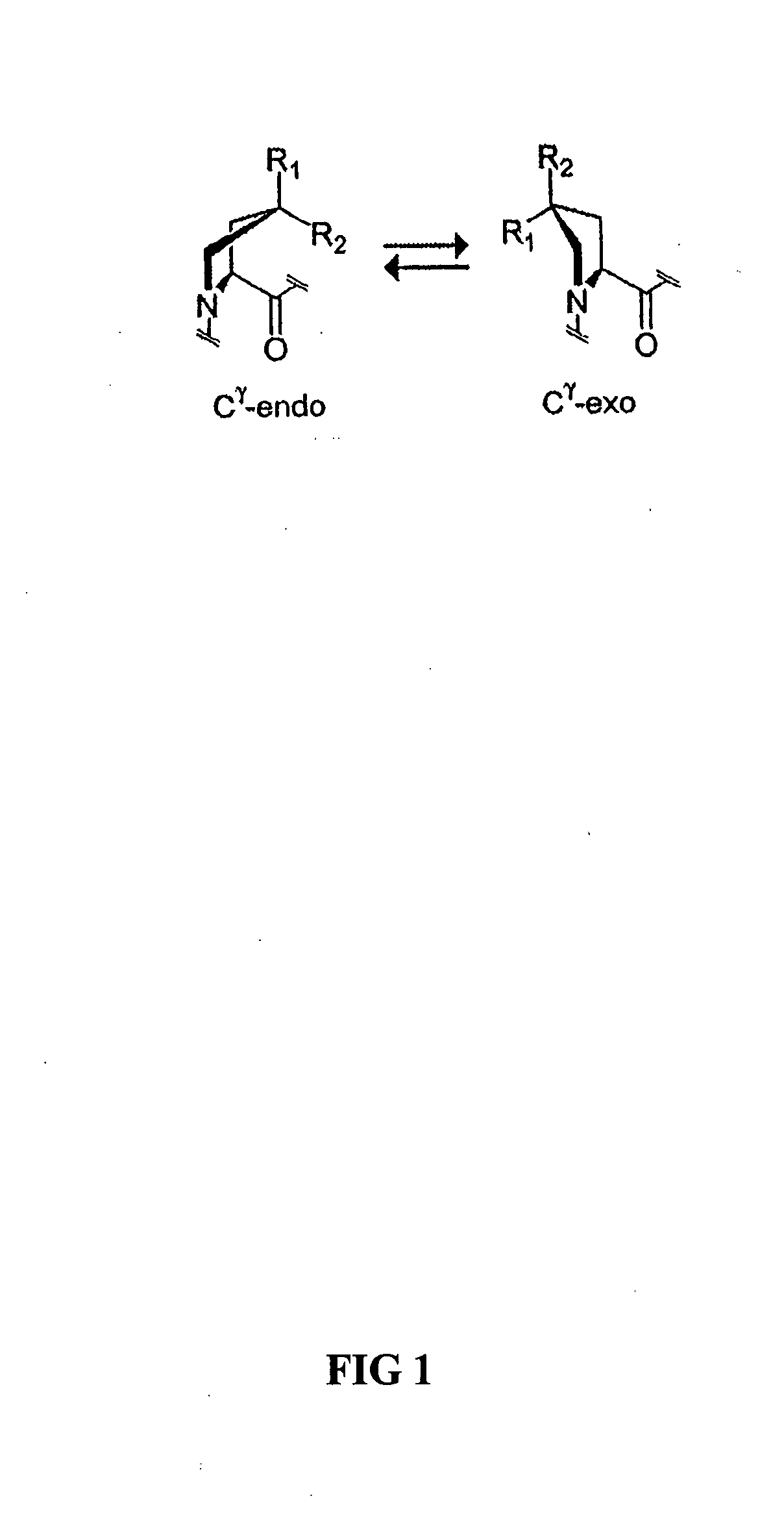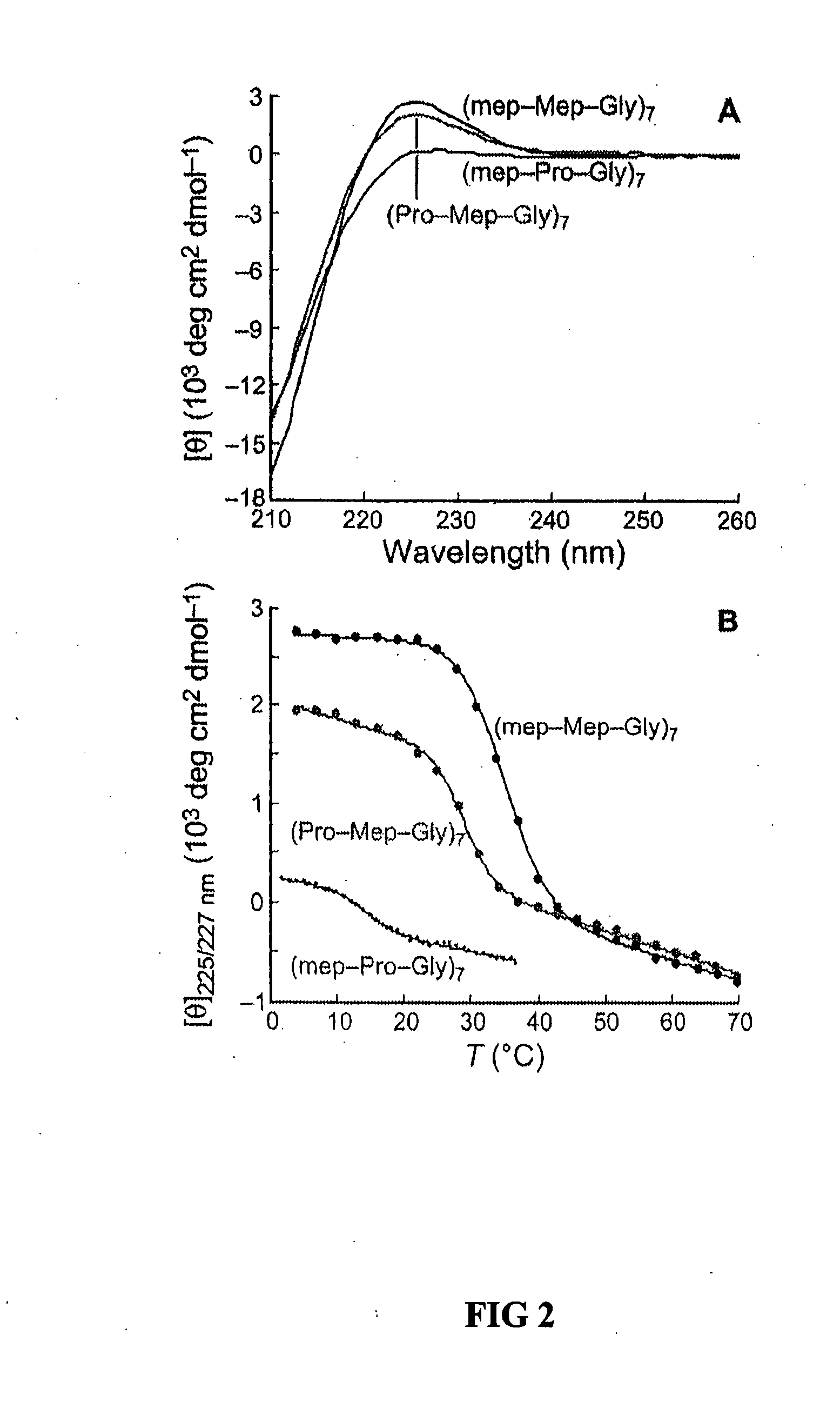Collagen mimics
a collagen and mimic technology, applied in the field of collagen mimics, can solve the problems of fragile nature of the graft during and after surgery, bridge the water molecule model, etc., and achieve the effect of increasing the stability of the helix
- Summary
- Abstract
- Description
- Claims
- Application Information
AI Technical Summary
Benefits of technology
Problems solved by technology
Method used
Image
Examples
example 1
Experimental Materials and Methods
[0049] Commercial chemicals were of reagent grade or better, and were used without further purification. Anhydrous THF, DMF, and CH2Cl2 were obtained from CYCLE-TAINER® solvent delivery systems (J. T. Baker, Phillipsburg, N.J.). Other anhydrous solvents were obtained in septum-sealed bottles. In all reactions involving anhydrous solvents, glassware was either oven- or flame-dried. NaHCO3 and brine (NaCl) refer to saturated aqueous solutions unless specified otherwise. Flash chromatography was performed with columns of silica gel 60, 230-400 mesh (Silicycle, Quebec City, Canada). Semi-preparative HPLC was performed with a Zorbax C-8 reversed-phase column. Analytical HPLC was performed with an Agilent C-8 reversed-phase column using linear gradients of solvent A (H2O with 0.1% v / v TFA) and solvent B (CH3CN with 0.1% v / v TFA).
[0050] The term “concentrated under reduced pressure” refers to the removal of solvents and other volatile materials using a r...
example 2
Synthesis of N-tert-Butyloxycarbonyl-(2S,4R)-4-methylproline (1) and (S)-2-tert-butyldimethylsilyloxymethyl-N-tert-butyloxycarbonyl-4-methylenepyrrolidine (7)
[0053] These compounds were synthesized by the method of Del Valle and Goodman M. J. Org. Chem. 2003, 68, 3923-3931. N-tert-Butyloxycarbonyl-S-prolyl-glycine benzyl ester (4) was synthesized by the method of Jenkins et al., T. Org. Lett. 2005, 7, 2619-2622. Synthetic routes to N-(9-fluorenylmethoxycarbonyl)-(2S,4R)-4-methylprolyl-S-prolyl-glycine 6 and N-(2-13CH3-acetyl)-(2S,4R)-4-methylproline methyl ester (2), N-(9-fluorenylmethoxycarbonyl)-(2S)-prolyl-(2S,4S)-4-methylprolyl-glycine (13) and N-(2-13CH3-acetyl)-(2S,4S)-4-methylproline methyl ester (10), and N-(9-fluorenylmethoxycarbonyl)-(2S,4R)-4-methylprolyl-(2S,4S)-4-methylprolyl-glycine (15) are summarized in FIGS. 3-5, respectively. The synthesis for compounds 16-19 are summarized in FIG. 6.
example 3
Synthesis of N-(2-13CH3-Acetyl)-(2S,4R)-4-methylproline methyl ester (2)
[0054] Following the method of Nudelman et al, Synth. Commun. 1998, 28, 471-474, compound 1 (80 mg, 0.35 mmol) was dissolved in anhydrous MeOH (11 mL), and the resulting solution was cooled to 0° C. Acetyl chloride (12.1 g, 150 mmol) was added dropwise and the reaction mixture was allowed to warm slowly to room temperature and stirred for 6 h. The resulting solution was concentrated under reduced pressure and the residue dissolved in anhydrous CH2Cl2 (15 mL). N,N-4-Dimethylaminopyridine (385 mg, 3.2 mmol) was added, followed by the dropwise addition of H313CC(O)Cl (250 mg, 3.0 mmol) and the reaction mixture was stirred for 24 h. MeOH (5 mL) was added to quench the reaction. The resulting solution was concentrated under reduced pressure, and the residue was dissolved in 10% w / v aqueous citric acid, extracted with CH2Cl2 (2×40 mL), dried over anhydrous MgSO4(s), and concentrated under reduced pressure. The crude ...
PUM
| Property | Measurement | Unit |
|---|---|---|
| Electrical conductance | aaaaa | aaaaa |
Abstract
Description
Claims
Application Information
 Login to View More
Login to View More - R&D
- Intellectual Property
- Life Sciences
- Materials
- Tech Scout
- Unparalleled Data Quality
- Higher Quality Content
- 60% Fewer Hallucinations
Browse by: Latest US Patents, China's latest patents, Technical Efficacy Thesaurus, Application Domain, Technology Topic, Popular Technical Reports.
© 2025 PatSnap. All rights reserved.Legal|Privacy policy|Modern Slavery Act Transparency Statement|Sitemap|About US| Contact US: help@patsnap.com



